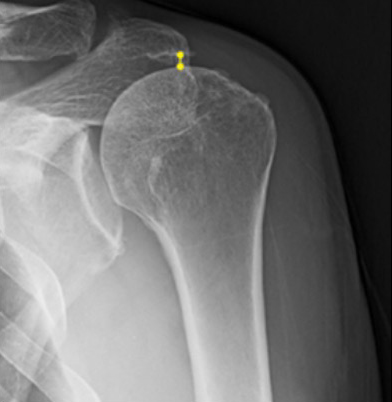Reverse Total Shoulder Replacement
What is a reverse total shoulder replacement?
The word “reverse” in the name of the procedure refers to the flipping of the concavities of the shoulder joint, so that the ball portion of the shoulder is effectively replaced onto the socket. This seemingly simple modification of shoulder anatomy has revolutionized the field of shoulder surgery since Paul Grammont in France introduced his concept of the reverse shoulder prosthesis in 1985(1). The original Grammont-inspired shoulder replacement has undergone many iterations of improvement over the last several decades and now is one of the most innovative and increasingly utilized orthopedic technologies in the world. After the reverse prosthesis received FDA approval in 2003 in the United States, it has exploded in utilization, outpacing the rate of increase in use of hip or knee replacements(2). The popularity of the reverse prosthesis is attributed in part to increased specialist orthopedic surgeon training, patient education and awareness of the implant, and access to the technology.
The reverse prosthesis is generally utilized when the rotator cuff is torn beyond repair, and when the shoulder stops functioning correctly due to the damaged rotator cuff. This leads to a condition called cuff arthropathy, where the joint (ball and socket) becomes damaged in addition to the rotator cuff.

Other reasons to consider reverse shoulder replacement are in conditions where traditional replacement is unlikely to work well either due to very severe arthritis where the joint shifts and erodes on itself or when the arthritic problem is accompanied with some thinning or atrophy of the rotator cuff tendons (as when patients are older). Both of these scenarios have better outcomes with reverse replacement, because stability is better and the prosthetic joint is no longer reliant on the soft tissues to balance it and allow it to work (as in the case of the traditional replacement).
Further less common indications for reverse replacement are fracture or injury sequelae, or when a prior surgery has failed, where the joint is badly damaged beyond repair and additional pain relief is expected with the reverse prosthesis technology.
By flipping the ball and socket, there is an artificial and stable fixed fulcrum that captures the arm, so that joint and tendon damage are bypassed, recruiting the bigger arm muscle (deltoid) to become the main motor for shoulder activity. Specifically, the reverse prosthesis moves the center of rotation closer to the native socket, so the deltoid becomes far more efficient at moving the arm away from the body for activity. Pain relief is achieved due to the prosthesis, where the damaged bones are no longer rubbing, and motion is improved because the deltoid muscle takes over for function.
Shoulder surgeon Dr. Obermeyer is actively involved in teaching other orthopedic shoulder surgeons how to perform reverse shoulder replacements, performs a high volume of reverse replacements compared with his peers, and uses the most cutting-edge technology including intraoperative navigation to ensure the components of the prosthesis are implanted as precisely as possible. Dr. Obermeyer performs revisions on reverse replacements that were performed by other physicians so he understands how failure mechanisms occur and how to prevent them.
The recovery from reverse shoulder replacement is not as challenging as one might fear. In fact, many patients find reverse replacement a far easier recovery than rotator cuff repair, which some patients may have previously undergone prior to having the shoulder replaced. The replaced shoulder is very sturdy and secure, and early gentle motion exercise with the surgical arm is permitted once pain permits shortly after surgery.
The surgery itself takes around one hour to perform and is done through a few-inch-long incision in the front of the shoulder. You can leave the surgical facility the same day or the day after and return home. A bandage is removed in five days when you can shower and get the incision wet.
A sling is maintained for one month to let the tissues heal, however simple activities with the hand in front of the body, including feeding oneself, washing hands, and getting dressed, are permitted immediately after surgery. Patients regain full use of the arm by two or three months with final subtle improvements noted well up to or past one year following surgery.
Minimizing risk is a top concern of shoulder surgeon Dr. Obermeyer, however, complications are possible even when appropriate precautions are undertaken. Infection, dislocation, fracture (during or after surgery), nerve injury, stiffness, pain are all possible but very uncommon. Consulting your primary physician to ensure you are medically fit to undergo surgery is important to prevent medical conditions such as heart arrythmias, strokes, and blood clots.
Schedule a shoulder consultation
If your in need of a shoulder replacement, schedule a consultation with shoulder specialist Dr. Thomas Obermeyer. Dr. Obermeyer specializes in shoulder replacement surgery. Dr. Obermeyer has orthopedic offices in Schaumburg, Bartlett, and Elk Grove Village, Illinois. Dr. Obermeyer regularly sees patients from throughout Illinois including Hoffman Estates, Palatine, Elgin, Streamwood, Arlington Heights, and Roselle communities.
References
- Flatow EL, Harrison AK. A history of reverse total shoulder arthroplasty. Clin Orthop Relat Res. 2011 Sep;469(9):2432-9. doi: 10.1007/s11999-010-1733-6. PMID: 21213090; PMCID: PMC3148354.
- Wagner ER, Farley KX, Higgins I, Wilson JM, Daly CA, Gottschalk MB. The incidence of shoulder arthroplasty: rise and future projections compared with hip and knee arthroplasty. J Shoulder Elbow Surg. 2020 Dec;29(12):2601-2609. doi: 10.1016/j.jse.2020.03.049. Epub 2020 Jun 9. PMID: 33190759.
At a Glance
Dr. Thomas Obermeyer
- 15+ years of training and experience treating complex shoulder and sports medicine conditions
- Expert subspecialized and board-certified orthopedic care
- Award-winning outstanding patient satisfaction scores
- Learn more

